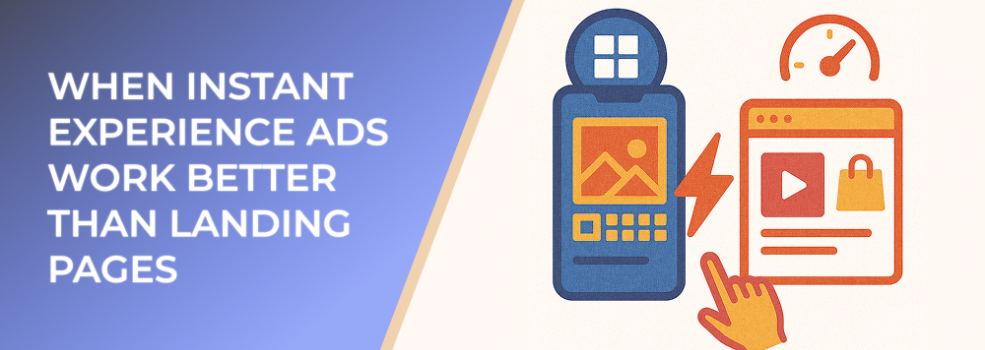Instant Experience (formerly Canvas) opens a full‑screen, native mobile experience after the ad is tapped. Because the content is preloaded and hosted within Meta’s ecosystem, IX can feel faster and more immersive than sending traffic to a mobile web page. But IX isn’t always the right move. This guide explains when IX beats a landing page, how to structure an IX for performance, and how to test without bias.
Why Instant Experience Can Win
-
Speed on mobile: IX preloads, so perceived load times are near‑instant. As a directional benchmark, many accounts see 20–40% higher click‑to‑view rates vs. slow mobile pages (3–5s+). Every extra second of mobile load time can depress conversion rate by 7–10%—IX avoids this penalty by rendering natively.
-
Fewer drop‑offs: IX keeps users inside the platform, reducing cross‑app friction, cookie consent modals, and layout shifts. Expect +10–25% deeper engagement (scroll depth, gallery views) when creative is built for touch.
-
Richer storytelling: Tap‑to‑reveal, carousels, video, and product tags create pathways that emulate a product tour or mini‑catalog without code.
-
Creative control without dev work: Marketers can ship fast iterations without engineering. This removes weeks of page edits and QA from many workflows.
IX shines when speed + storytelling matter more than complex onsite logic.
When Instant Experience Outperforms Landing Pages
-
Your mobile LP is slow or heavy. If Lighthouse shows >3s TTI or >2.5s LCP, test IX while you fix the page.
-
Visual, discovery‑led products. Fashion, beauty, home decor, gadgets—where first‑impression visuals drive action.
-
Catalog selling. Collections with 5–20 products benefit from IX galleries and product tags that jump to PDPs only when intent is high.
-
Story‑driven offers. Launches, bundles, and founder stories that need video + UGC + before/after in a single scroll.
-
Limited dev bandwidth or strict CMS. When spinning up new LPs is slow, IX enables rapid concept testing.
-
Markets with unstable mobile networks. Preloading reduces bounce from spotty connections.
When a Landing Page Still Wins
-
Complex paths (configurators, quizzes, multi‑step forms, financing checks).
-
Deep SEO needs: content meant to rank organically belongs on your site.
-
Advanced analytics that require site‑level events or server‑side logic only available on your domain.
Building a High‑Converting Instant Experience
Structure (top to bottom):
-
Hero hook (0–2s): bold visual + micro‑promise; video or cinemagraph works well.
-
Value blocks: 3–5 tiles (benefit → proof) with icons, short copy, and tap targets.
-
Social proof: star snippets, UGC frames, quick testimonial video (6–10s).
-
Product grid: 6–12 SKUs with tags; prioritize top sellers.
-
Primary CTA: Shop Now / Start Free Trial.
-
Safety net: returns, shipping, guarantees, payment methods.
Creative guardrails
-
Keep copy under ~40–60 words per section; use scannable bullets.
-
Aspect ratios: vertical video 9:16; images 1080×1920 or 1200×1500 for grids.
-
Load budget: prefer images over heavy video; compress to keep total asset weight light.
-
Accessibility: captions on all videos; color contrast that clears WCAG AA.
Measurement and Events
-
Configure IX component tracking (button taps, link clicks, time in view, scroll depth).
-
Optimize to purchase or qualified lead once you hit volume; otherwise start with add‑to‑cart or complete registration.
-
Compare IX → PDP paths vs Ad → LP paths on: CTR, landing rate, add‑to‑cart rate, and CPA.
Directional targets to evaluate a win:
-
Landing rate (ad click → content view): IX +15–30% vs LP when the page is slow.
-
Add‑to‑cart rate from content viewers: within ±10% of LP or better.
-
CPA/ROAS parity or ≤ 10–20% lower CPA sustained 2+ weeks at target spend.
Fair Testing Framework
-
Split budgets: run twin ad sets—one deep‑linking to LP, one opening IX—same geo, audience, optimization, and attribution window.
-
Creative parity: build IX from the same concept/s as the LP hero.
-
Learning volume: aim for ≥ 50 purchases/week (or ≥ 100 qualified leads/month) before deciding.
-
Holdout check: add a small broad prospecting cell to ensure no systemic bias.
LeadEnforce Workflow
-
Audience hygiene: normalize identifiers, SHA‑256 hash, and deduplicate to raise match rates feeding your IX tests.
-
Segmentation: prospecting vs. engaged vs. cart/lead vs. buyers; ensure mutually exclusive sets to avoid overlap.
-
Creative mapping: tag assets by concept and by destination (
IXvsLP) for clean reporting. -
Automations: weekly refreshes of seeds and suppression lists (recent buyers, refunds, employees/test accounts).
-
Reporting: monitor landing rate, add‑to‑cart, CPA/ROAS by destination type.
30/60/90‑Day Plan
Days 0–30
-
Build 1–2 IX templates (story‑led and catalog‑led).
-
Launch split tests against your current best LP.
-
Baseline metrics: landing rate, ATC rate, CPA.
Days 31–60
-
Scale IX if CPA within ±15% of target and landing rate is ≥ +15% vs LP.
-
Expand to 2–3 collections; add localized variants if needed.
Days 61–90
-
Layer IX into retargeting (0–7, 8–30 day engagers).
-
Institutionalize a quarterly creative refresh and a monthly performance audit of IX vs LP.
Troubleshooting
-
High engagement, low ATC: curiosity creative—tighten offer clarity and pricing; push users to PDP earlier.
-
Great ATC, weak checkout: checkout friction—ensure deep links resolve to cart or PDP with preserved session.
-
Under‑delivery: reduce media weight; simplify assets; test Advantage placements with strict exclusions.
KPI Checklist (copy/paste)
-
IX landing rate ≥ +15% vs LP
-
ATC rate within ±10% of LP or better
-
CPA at or ≤ target for 2+ weeks
-
≥ 3 IX concepts live (story, catalog, offer)
-
Suppress recent buyers/refunders within 48h
-
Weekly creative and destination review completed
Suggested Reads from the LeadEnforce Blog
-
Audience Hygiene 101: Formatting, Hashing, and Deduplication Best Practices
-
Lookalike Audiences: How to Seed, Train, and Scale
-
Retargeting Without Waste: Exclusions, Frequency Caps, and Creative Rotation
Takeaway
Instant Experience ads are not a universal replacement for landing pages, but they can outperform when mobile speed, visual storytelling, and quick iteration are decisive. Use disciplined tests, measure the right conversion steps, and scale IX where it wins—while continuing to improve your landing pages for long‑term leverage.

